The Google Nexus 5X Review
by Brandon Chester on November 9, 2015 8:00 AM EST- Posted in
- Smartphones
- LG
- Mobile
- Android 6.0
- Nexus 5X
GPU Performance
CPU performance is one side of an SoC, while GPU performance is the other side. With two years of GPU development between the Nexus 5 and the 5X we're hopefully looking at a substantial uplift in GPU performance. Qualcomm's official figures peg Adreno 418 as 20% faster than Adreno 330 in graphics workloads. To characterize the Nexus 5X's performance during graphics workloads that are similar to those a 3D game would provide I've run it through our standard GPU-focused benchmarks. The first is 3DMark, followed by BaseMark X and GFXBench 3.0.

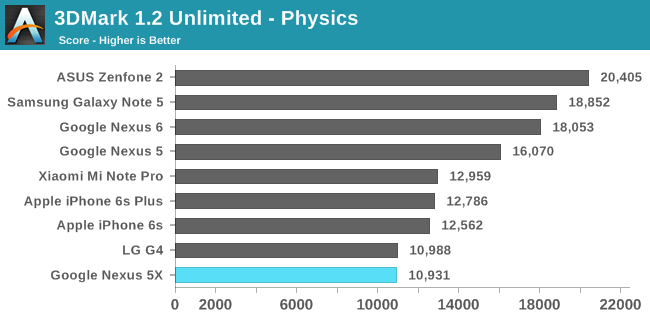
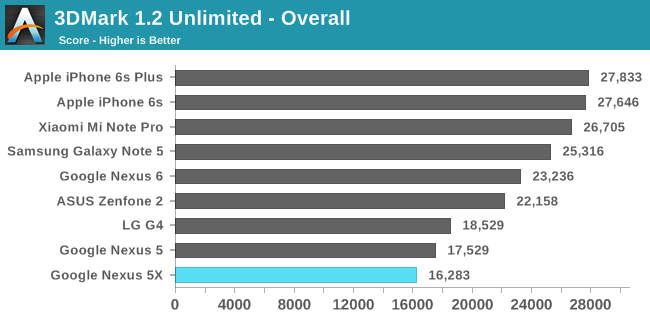
The Nexus 5X ends up actually coming in below the Nexus 5 in 3DMark's overall score. This is the result of the much lower score in the physics sub test. However, it's worth noting that the 3DMark physics test has heavy data dependencies and all of our tested devices with bigger out of order cores end up doing poorly. While this is a possible scenario in a real-world program, I wouldn't make too many conclusions from the Nexus 5X's performance here. In the graphics test there's actually a surprising gap between the 5X and the LG G4 which uses the same SoC, and I've been unable to get a score anywhere near it no matter how many times I re-run the test. At least in 3DMark it looks like the LG G4 has a bit of a lead over the Nexus 5X.
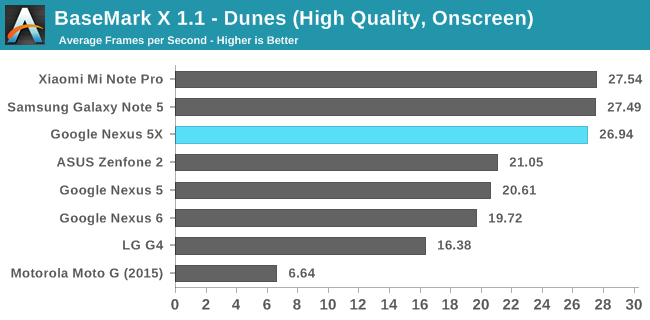
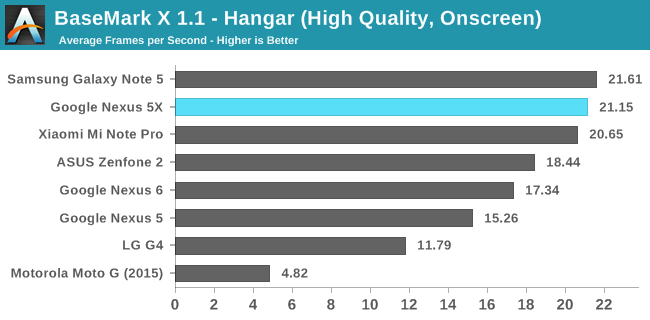
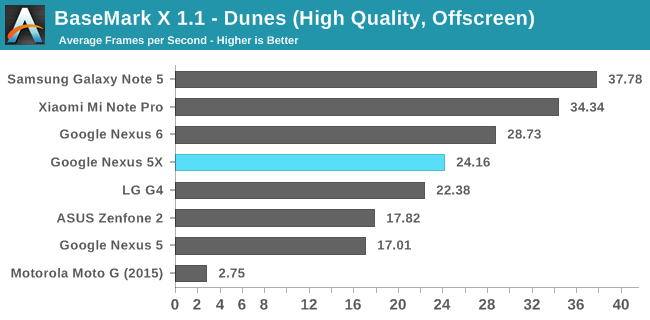
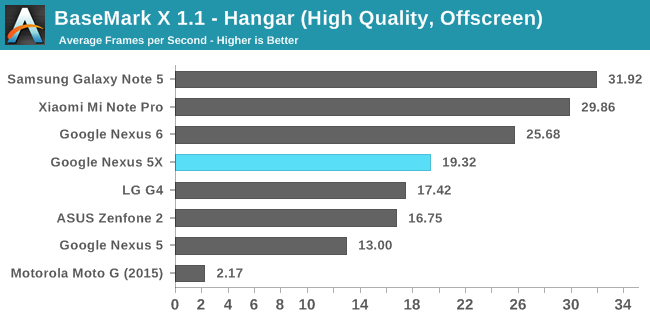
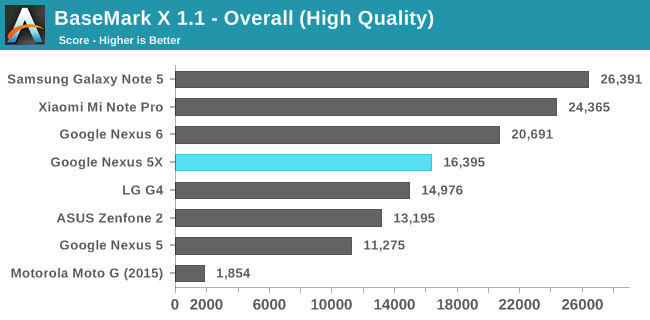
BaseMark X's results are more in line with what I expected to see from the 5X's GPU. The on-screen results are far ahead of the LG G4, which isn't surprising at all when you consider that the G4 is driving a 2560x1440 panel while the 5X is pushing 1920x1080. Both off-screen results are close enough that they could be ascribed to margin of error, and ultimately BaseMark X shows that there's not really any gap between the absolute performance of the G4 and the 5X, but the 5X will definitely be faster for anything running at native resolution.
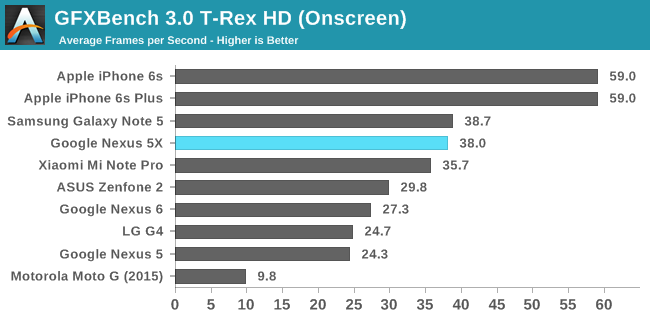
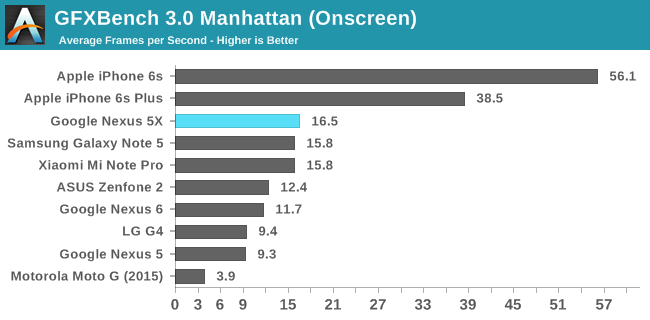

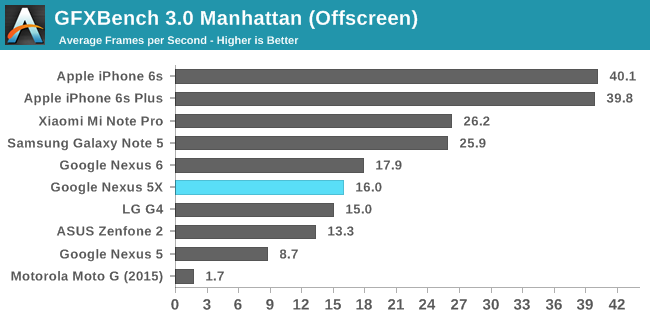
The results in GFXBench echo those of BaseMark X. The 5X beats the G4 in both off-screen cases, but only by a small margin. With the 5X being slightly faster than the G4 in both GFXBench and BaseMark X we may be looking at some small driver improvements here, but since all the gaps are so small it may just be coincidence that the 5X is the faster of the two devices in both tests.
Ultimately, both Adreno 418 and 430 are pretty good GPUs, and with the Nexus 5X being priced at $379 I think it offers more than adequate GPU performance for its price. What's interesting is that even though we didn't see Snapdragon 805 show up in many devices, it was in the Nexus 6, and its Adreno 420 GPU is definitely a bit faster than the Adreno 418 in the 5X. The Nexus 6 was also priced much higher than the 5X, and so with the 5X you're definitely getting a lot more GPU performance for your money than you got with the Nexus 6. The performance uplift is definitely greater than Qualcomm's stated 20%, and it's always nice to see something beat expectations.
NAND Performance
When I originally reviewed the Nexus 6 I decided to publish the review without any storage benchmarks, because in my testing I noticed that the results I was getting simply did not add up. Futher investigation revealed that it was the result of the Nexus 6's forced Full disk encryption (FDE), and the encryption and decryption of data being done without the use of high speed, power efficient fixed-function hardware. Later on in the Nexus 9 review Josh noted that there was a significant uplift in NAND performance compared to the Nexus 6, and it was clear that the AES/SHA instructions that are part of the ARMv8 instruction set were helping to reduce the performance impact of FDE.
Since Snapdragon 808 supports the ARMv8 ISA this presents a good opportunity to revisit this topic. The Nexus 5X shares several things with the LG G4, and one of them is its NAND, which is an eMMC 5.0 solution provided by Toshiba with the model number 032G74. While there's not much public information on this storage solution, one would expect that NAND storage speed results from the Nexus 5X closely match those of the LG G4, as if that isn't the case then it's clear that FDE causes a noticeable loss of performance despite ARMv8's cryptographic instructions.
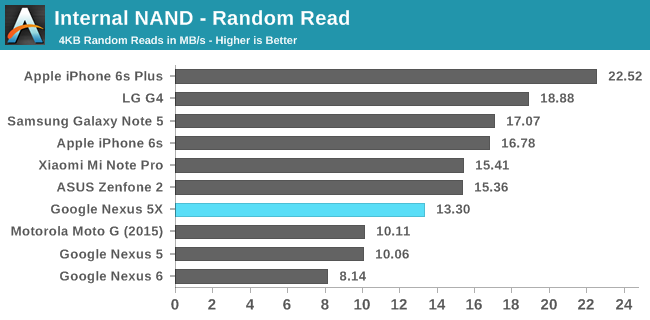
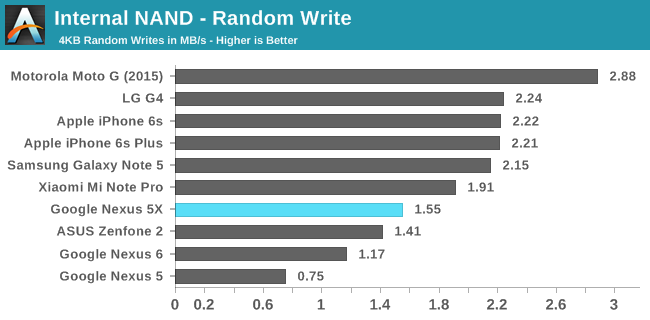
Random read and write speeds both take a hit when compared to the LG G4. While the gaps don't look enormous, the performance with small transaction sizes on mobile devices is hardly great to begin with, and so even these small gaps can matter greatly. In this case both random read and write speeds are both about 30% lower than the G4, which is significant.
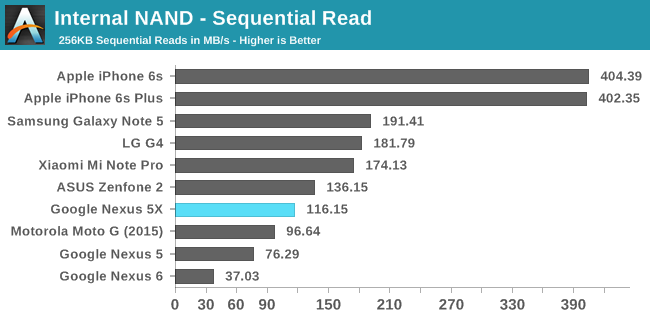
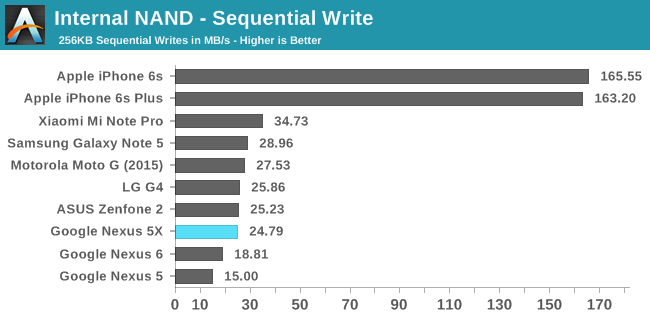
Sequential write speeds on the 5X end up being about equal to the G4, but the gap in sequential read speeds is enormous. Altogether, it's clear that there's still a significant reduction in NAND performance caused by the use of FDE when only using ARMv8's cryptographic instructions to encrypt and decrypt data to be written. This contrasts with comments made by Google engineer David Burke during a Reddit AMA discussing the FDE situation on the Nexus 5X in response to a comment that was referencing the Nexus 6's poor storage performance. What's interesting is that ARM has stated before that the ARMv8 cryptographic instructions are not a substitute for fixed-function hardware, and so it looks like there's a disagreement between ARM and Google on whether or not this is an adequate solution for encryption.
Reduced storage performance is not the only problem with this solution. Waking up the AP to do encryption or decryption every time the disk has to be read from or written to incurs a huge power penalty compared to simply using a hardware AES block and DMA which happens to be what Apple has been doing for about six years now. There are power savings here just waiting for Google to grab them, but they've decided not to do so for a second year now. Google certainly has an interest in getting Android phones to use FDE out of the box in order to combat negative perceptions about Android's security, but I don't think it's acceptable to have such a policy without the necessary hardware to make sure it doesn't affect the device's performance to any significant degree.
The Nexus 5X is certainly in a much better situation than the Nexus 6 was, but Google's FDE policy means you still get significantly reduced storage performance across the board compared to a device with the same NAND. This has various ramifications, ranging from data transfer speeds, to app install times, to performance when apps are updating in the background, to the ability to rapidly take photos and record high bitrate video. I really wish Google would either not ship with forced FDE and allow it to be disabled, or implement the necessary fixed-function AES hardware to avoid the significant performance hit.










197 Comments
View All Comments
zeeBomb - Monday, November 9, 2015 - link
Same! I'm kinda in that position as well. Maybe a Z5 premium review would be cool too.Bob Todd - Monday, November 9, 2015 - link
As someone with 3 OnePlus Ones in his household, I'd tell you to run like hell toward the Nexus. The software situation is kind of a disaster for OnePlus. Fun bugs like this one where your phone won't really work as a phone for lots of users in VoLTE markets (no cellular when connected to WiFi) that go unfixed for months on end.https://jira.cyanogenmod.org/plugins/servlet/mobil...
The issue affects all 5.x radios so OxygenOS is impacted too. Then there's crap like them not fixing the Google Play Services battery drain bug in other patches even though it was a 10 minute fix in framework-res. It wasn't hard to ignore my invite for the OnePlus Two.
yankeeDDL - Monday, November 9, 2015 - link
I owe a Nexus4 and a Nexus5. Both in service and without an issue for 3 and 2 years respectively.The Nexus5 battery is starting to show signs of aging (I do still get 1 full day without charging if I limit the use, but I need to watch it).
I decided to buy a new one, but the thought of getting a new, better phone, is appealing. I owe the N5 32GB. It baffles me how there are still phones around with 8/16GB, as 32GB feels definitely tight. I guess it depends on the use one does of it, but my photos folder easily goes to 6~8GB in few weeks. Add to this 10GB of music, and there's little space for videos, games and what not. So the OnePlus X with a nice 128GB SD card sees extremely attractive, especially at that price point, using an 801 which does not overheat and does not drain the battery, and a decent size screen.
If it was a Nexus, I would not think twice. But it isn't, hence I looked forward to the N5X.
Problems: only 32GB and in Europe, it is priced at 529eur. That's 570usd. Seriously? Unfortunately, yes. The OnePlus X is nearly half of it (supposedly) and it has an SD card and a larger battery and a slightly smaller screen (a plus, in my opinion). The camera will likely not be up to that of the N5X, but still, I have a real camera when I want to take "nice" photos. To "capture the moment", I'm OK with the N5 so, I suppose, I'd be OK with the One+X.
Thanks for the feedback on One+: I do have some colleagues who have it and they did not seem t have any major problem.
UtilityMax - Monday, November 9, 2015 - link
My OnePlus One has been working great, though I have to say I never bothered to upgrade from the original ROM it shipped with some time in March.UtilityMax - Monday, November 9, 2015 - link
Based on reviews I have seen, OnePlus X suffers from the same shorter (not 5X though) battery life, heat and throttle issues as any other device using the current crop of the 64-bit Snapdargon SoCs. I have heard from a bunch of people already that they'd rather hang onto their old phones than buy the ones with the current 64-bit Snapdragon SoCs. I have one OnePlus One phone in the family, and I have to agree with them. The One is still a fantastic phone, and you can buy the 64GB version for $300 in the USA, no invites necessary.If you do want to buy one of those two, OnePlus X seems like a nice deal on paper, in the sense that all specs look slightly better.
UtilityMax - Monday, November 9, 2015 - link
Err.. sorry, I was talking about OnePlus 2 above. The OnePlus X is an excellent smart phone, but unfortunately it lacks the bands for optimal LTE service in the USA.DukeN - Monday, November 9, 2015 - link
Good job as always not giving two fucks about non-Apple devices Anandtech.Apple devices - reviews on the first day of release/reveal.
Anything else - we'll get around to it (This is like five weeks after the first reveal). And uh, maybe should have reviewed the 6P which is probably the best handset around?
No wonder this place is in the toilet relative to a few years back.
Brandon Chester - Monday, November 9, 2015 - link
The iPhone 6s was released on Sept 25, our review went up on Nov 2. The Nexus 5X was released on Sept 29, and this review has gone up on Nov 9. Accounting for the fact that we don't publish on weekends the gap was the same. I don't see how we give preference to Apple devices at all.Furthermore, I received the 5X well after other publications did, and Google didn't send a 6P along with it. We just sourced one from Huawei and so that review will take some time to do properly. Google's lack of organization in getting press hardware and software in a timely manner is why, for example, I can have an iOS review done for launch day but not an Android Marshmallow one.
Also, if you're going talk about things a few years back I suggest you look at how long the HTC One M7 review took. Doing things right takes time, and there are lots of other places to get a 24 hour review.
trekinator - Monday, November 9, 2015 - link
Thanks Brandon. Most of us appreciate the time it takes to do things right.bw13121 - Monday, November 9, 2015 - link
I'll second that. Fantastic quality and in depth review. There are those of us who do appreciate the quality and technical depth of your reviews, as most reviews are that light on detail they are useless!